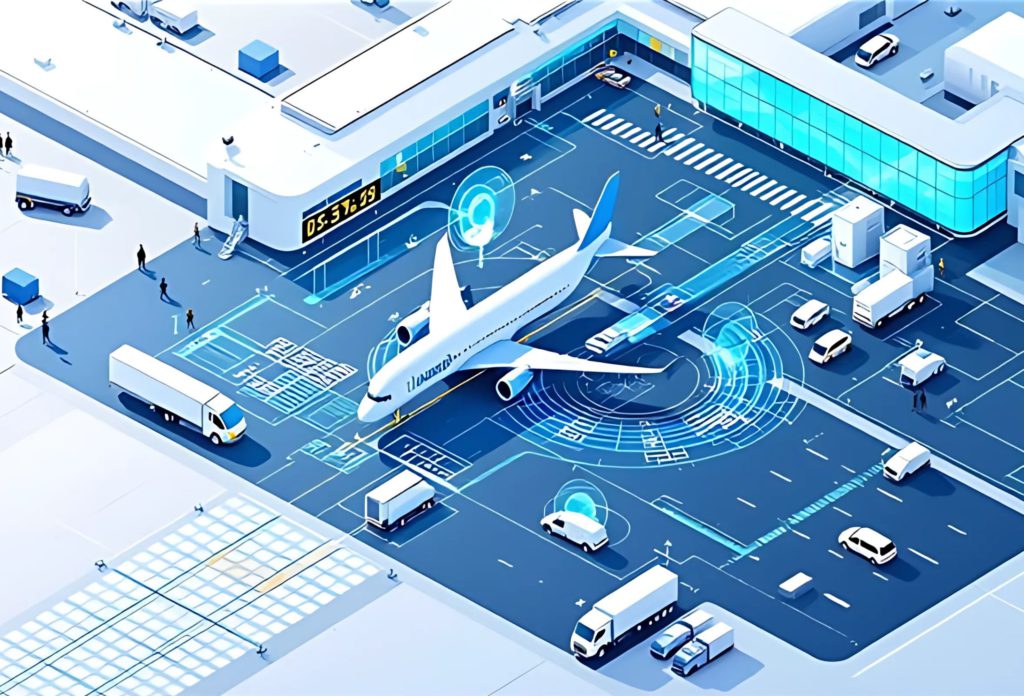PROJECT OBJECTIVE
In modern aviation, the safety and efficiency of ground operations represent a crucial challenge. The AVIO project was born with the ambitious goal of revolutionizing airport management through the creation of a cutting-edge digital twin. This digital replica provides a real-time virtual representation of the airport environment, capable of tracking and monitoring every movement of aircraft, vehicles, and operators through sophisticated artificial vision modules.
The true innovation of the project lies in its ability to provide operators with a crystal-clear and immediate view of the entire airport environment. This allows them to make more informed and timely decisions in managing ground traffic, identifying potential inefficiencies before they transform into real problems. The system goes beyond passive monitoring, becoming a proactive tool for accident prevention and optimal management of airport resources.
The implemented technology innovatively combines artificial vision with virtual reality, creating a fully immersive simulation environment. This not only allows monitoring of ongoing operations but also offers a revolutionary platform for training airport personnel, who can practice in realistic scenarios without operational risks.
THE POWER OF COLLABORATION
The AVIO project represents an excellent example of synergy between major players in the aviation software engineering sector. The collaboration sees SACBO S.p.A. in the role of coordinator, alongside strategic partners such as TXT e-tech, SORINT.tek, and the University of Pavia. This partnership is further enhanced by co-funding from the Ministry of Enterprise and Made in Italy through Innovation Agreement funds (PNRR), testifying to the project’s strategic importance for national innovation.

TECHNOLOGICAL CHALLENGES
The beating heart of the AVIO project lies in its technological complexity. The vision and artificial intelligence modules must operate in an extremely dynamic environment, where lighting and weather conditions are constantly changing. To overcome this challenge, the team is implementing the most advanced solutions in deep learning, reinforcement learning, and self-supervised learning. These systems are designed to recognize, track, and predict events in real-time, setting new standards in the industry.
Data management represents another fundamental challenge. The team is developing innovative solutions for integrating information flows, defining complex ontologies that allow meaningful data representation and correlation. The architecture has been conceived to be highly scalable, with customizable visualizations and intelligent filters ensuring that each operator has access to exactly the information they need, when they need it.

SORINT.tek’s DISTINCTIVE CONTRIBUTION
SORINT.tek plays a fundamental role in the project, focusing on two critical streams: the development of the AI/CV module and the implementation of the data hub. In the field of artificial vision, the company is developing cutting-edge systems for classifying and tracking vehicle and personnel movements. These systems go beyond simple object identification, understanding in real-time the actions performed by various actors present in the airport area.
The collected information flows into the Data Hub, an evolution of the MangroviaIoT platform, which transforms raw data into structured information immediately usable by the Digital Twin. The system, ISO 27001 certified, guarantees not only efficiency but also maximum security in sensitive data management.
EXPECTED RESULTS AND IMPACT
The AVIO project aims to establish new standards in the airport sector. Expected results include the development of artificial intelligence models capable of identifying and tracking complex events in real-time, overcoming current limitations in action recognition systems. The implementation of semantic approaches will also allow the definition of complex query scenarios, opening new possibilities in airport management.
This innovation represents a significant step forward in airport operations safety and efficiency, promising to radically transform how we manage and monitor ground activities in the airports of the future.

